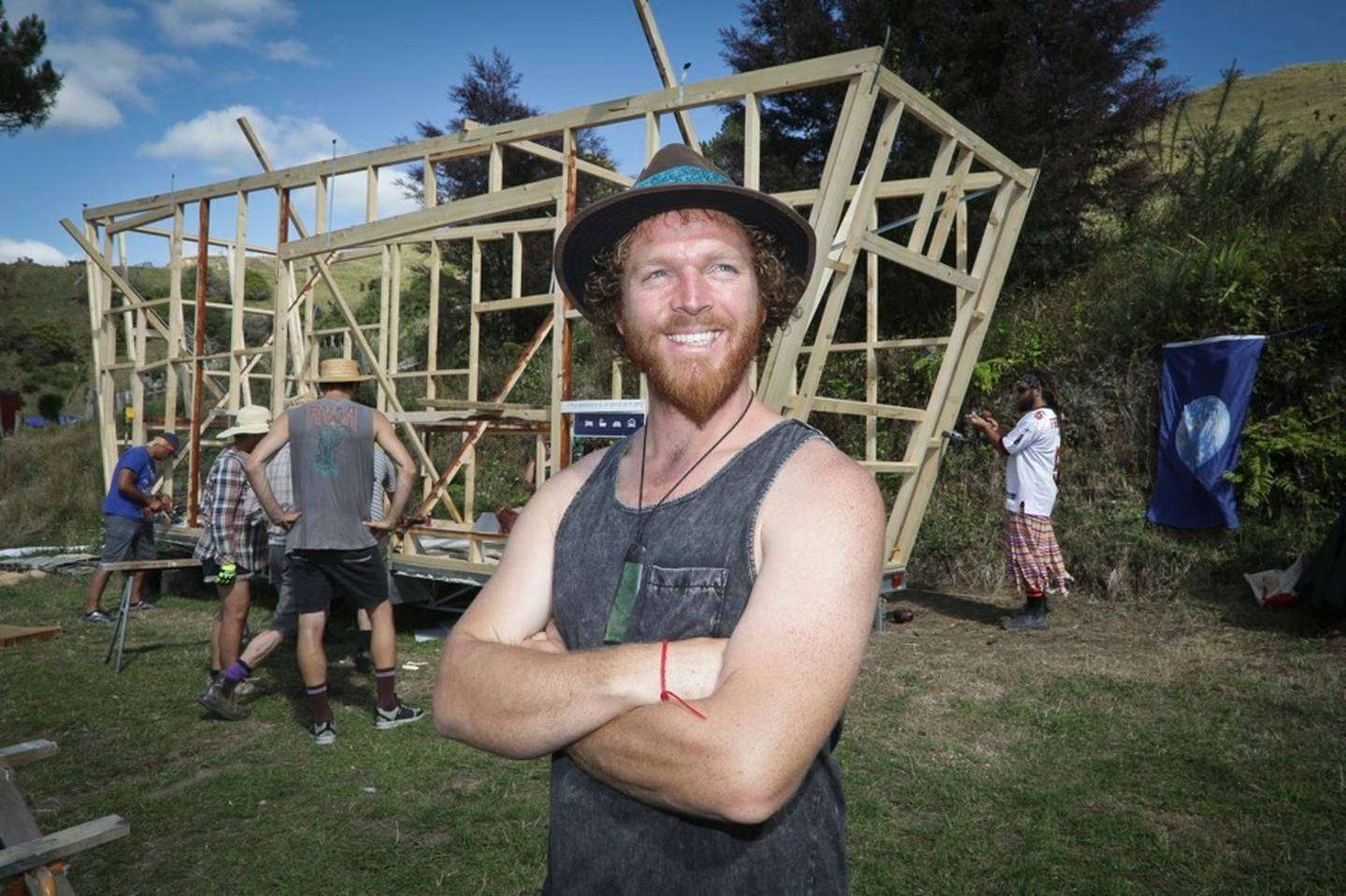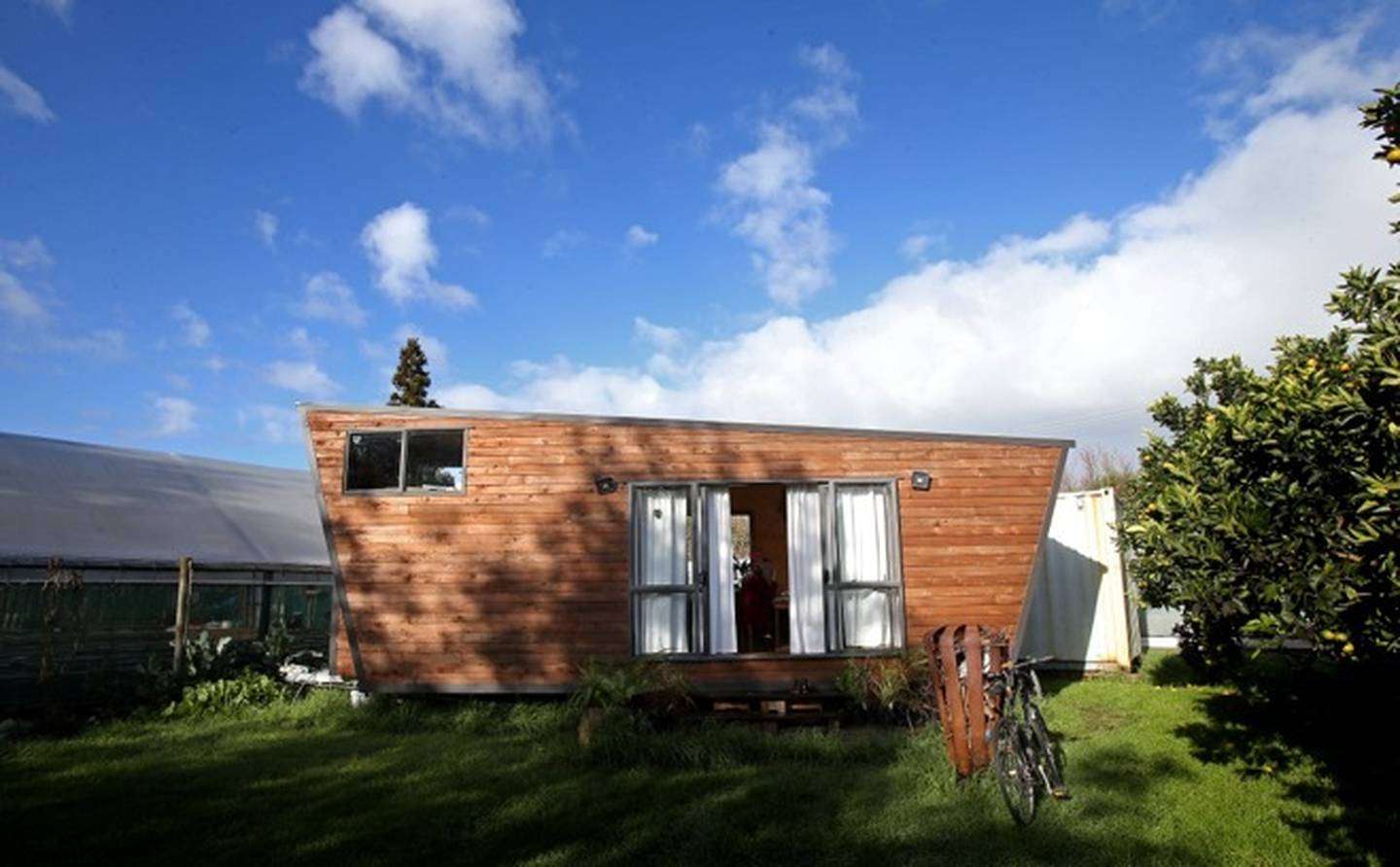WHEN you lead a minimalist life, it's hard to go unseen.
As I tramp through overgrown wet grass, I spy Leo Murray inside his house on wheels, with his back to me.
He's tidying up and appears to be deliberating on where to move a medium-sized pot plant.
It's a cold May morning in the Bay of Plenty, but the sliding doors are wide open.
Start your property search
I disrupt his concentration, and he greets me with a visible puff of breath and an enthusiastic: "Welcome, welcome! Don't worry about your boots; I'll just sweep afterwards."
On his feet are brown leather, sheepskin slippers.
"This is my little house," he says of his trapezium-shaped home, which measures 7.6m at the base, 10.2m at the top, 2.5m wide and 4.15m high.
It's made out of chemical-free timbers, lawson cypress, gum and redwood - sourced from the Bay of Plenty - and insulated with local sheep wool.

The house, shared with his wife, Tara, is the result of New Zealand's first tiny house building workshop in the Tauranga suburb of Te Puna, in March 2017.
The workshop attracted participants from as far afield as Sydney and Perth, and the house served as a significant case study for small-space architecture in New Zealand, debt-free housing and low-impact living.
It is equipped with all they need to live, seeking to challenge the concept of traditional housing; and they've lived in Matapihi, on a rented space, since February.
He has plans to build more shelves and a deck that fits road specifications. "Trundle off to the next place," he says.
Is there anything he doesn't like about tiny houses?
"The ability to host. [Although] we had seven people around this [kitchen island] the other day; it was sweet."
From my seat on a boho-cushioned bar stool, the view from the 'lounge' window sitting between a couch and bunk bed is of fully-laden orange trees.
"The soil is bangin'," Murray says, nodding his head approvingly.
The surrounding orchard also boasts macadamia nuts, walnuts and avocados.
Outside and resting against a brazier, is one of his four pushbikes. He prefers biking than driving, and not unintentionally, has a bike for every terrain.
"I just have this insane, creeping guilt every time I turn the key of a car," he confides.
He's currently reading David Holmgren's Retrosurbia, which promotes the notion that communities can get their needs met solely within their neighbourhood and "retrofit" suburbs for an uncertain future.
This appeals to Murray, who is a sustainability consultant and permaculture designer.
He's wearing a brown coat from an op shop, and a white T-shirt with "foliage" print.

He wears a lot of green and general "earthy colours", and always has his pounamu necklace around his neck. It was a gift from Tara 12 years ago, from Parihaka in Taranaki.
He is Pākehā with Scottish, Irish and Scandinavian roots, but he's enamoured by Māori culture and is learning te reo. He threads in the odd Māori word throughout his sentences.
"The values that are embedded in the language of te reo Māori really speak to me. The care for the community and the guardianship of the land; that's something that I hold quite closely."
In the past, he's hit the headlines for his role as a "dumpster diver", taking food from supermarket skip bins to raise awareness of food waste in the community.
A video of him last year on social media, showing off a rubbish skip haul, received tens of thousands of views online.
He goes hunting for waste less frequently nowadays.
"It just wasn't really working with the way that I wanted to eat. I'd have like 40 cakes. Where would I put it?" he says scanning his torso with his hands.
He also owns the business, Why Waste, which sets out to improve community and ecological resilience.
His current project is tackling residential food waste. Part of the project is leasing out worm farms to households, and teaching residents what is synthetic waste and what is compostable. It's his dream to have a worm farm in every Kiwi backyard.
He's also involved in teaching kids about gardening and edible landscapes.
Furthermore, he's one of the first in New Zealand to be a student of Otago Polytechnic's new bachelor's degree, Leadership for Change; and along with a group of friends, has created the unique community group, Chur, which aims to bring people together for festivals, creative inspiration, self-expression and support.
Murray wears a lot of hats - literally. He's got a collection of fedoras on display in his tiny house, saying with his complexion - fair skin, red hair and cerulean blue eyes - he can't afford not to cover up.
He picks out a flax woven fedora, made by a Wellington artist, and pops it on his head for the duration of our interview.
He plays with his beard while he talks, giving thought to his answers.
"I've always done things differently," he concedes of his personality.
The youngest of three boys, he was born 30 years ago via a home birth, in the lounge of a Papamoa house that his "Greenie" parents, Tony and Wendy, designed and built.
As a child, he enrolled himself at Papamoa Primary School, and took the bus to school on his first day, by himself.
He grew up in both Papamoa and Pukehina and attended Te Puke High School, where he met his freelance graphic designer and yoga instructor wife, Tara.
He moved to Wellington after leaving school and obtained a triple major in international relations, media studies and political science, smack-bang in the middle of the Global Financial Crisis of 2007–2008.
With work opportunities scarce, he became "DJ Mufasa" fulltime for a decade, including a stint overseas playing music in five continents. He loves anything with bass and owns a treasured pair of 45-year-old antique headphones.
Evidence of his travels is peppered throughout his house, including a hand-painted blue and white tequila bottle from Mexico. It's sitting next to three lampshades in the shape of "hops flowers" still waiting to be hung.
"It's all about quality over quantity," Murray says of his belongings and art on display.
Building a tiny house was a bit of an "experiment" and stepping stone, with his ultimate aim to utilise his permaculture skills and build an earthen home out of clay and straw "and really be a part of the landscape".
His tiny house cost him just under $70,000 and replicates what many in the United States did to combat the housing crisis, which is a tiny house social and architectural movement.
"The Global Financial Crisis meant a lot of people lost their houses, but the children of those people had their eyes open. They're educated, and looking at their folks that have just lost their home and thinking: 'Whoa, that's not what I want for my life.'
"A lot of them, thousands of them, built houses on wheels. The tiny house movement is really working for my generation that likes to move around a lot."
Unlike house buses and caravans, which have been "creative small spaces for generations", the demography of who is building tiny houses, and living in them, influences how they are perceived in society, he believes.
"I think the reason [society] treat tiny houses different is the privilege of the people who built them. Broadly speaking, people who build tiny houses are young, upwardly-mobile, white, educated, well-off people, whereas people who live in house buses are generally marginalised people in society."
Gypsies?
"That's it.'
Murray says one thing that needs to be overcome for the tiny house movement, however, is red tape by councils.
"Local authorities are doing all they can to allow for expansions of population in their regions, but they're also really slowing it down, so it's a difficult one. If a house is mobile and not permanently embedded in the landscape, then I think that solution going forward can be a lot more viable than all these [cheaply made] houses popping up everywhere."
Tiny houses could also be a good option for "tangata whenua" and Māori-owned land, he says.
While happy to be outspoken, Murray is less so than when he lived in Wellington. He lived in an activism and protest sphere, where "ineffectual outcomes" wore him out, he says.
"You get activist burnout. I'm passionate about participation in society, and it seems we have a lot of spectators."
In March 2017, Murray's Why Waste helped sift through 13,913kg of waste from Tauranga City Council rubbish bags, private rubbish bags and private collector rubbish bins to collect data for the audit.
The city-wide audit found 70 per cent of waste sent to landfill from Tauranga kerbside collections could be recycled or composted.
Earlier this year, when the council announced that glass would no longer be collected with roadside recycling, the initial crowd swell of protest got Murray excited, but quickly and disappointingly lost momentum, he says.
"It's those emotions that we can use to drive a positive change, and the glass fiasco is just symbolic of that."
"I go to council meetings, and more people are complaining about the tree that's blocking the view of their multimillion-dollar house, than 'where's our art galleries and museums?' Where are these things that bring people together?"
Murray's civic muscles are strong.
"I can't sleep if I'm not doing anything to effect change," he says.















































































